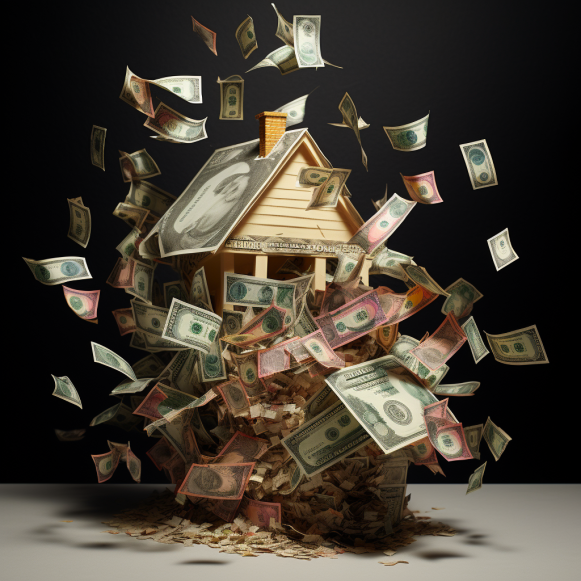Wages are finally rising faster than inflation, but why don’t we feel it?

Between his two jobs and side hustles, Glenn Stellwag is making more money than ever. Even so, due to inflation, he feels like he’s barely scraping by most months.
Stellwag, 41, has worked at a local hardware store near his Michigan home since a back injury cost him his job at a sawmill six years ago. He stocks shelves, rings up merchandise, and assists customers four days a week from 9 a.m. until around 6 p.m. Stellwag, on the other hand, took a second job with a tow truck company last October when he felt he “couldn’t afford to live anymore.” He’s on call six days a week from 7 p.m. to 7 a.m. He doesn’t have a single night off from work because of how his schedules are set up.
He’s since added jobs repairing lawn mowers and small engines to his resume. His total monthly income ranges between $2,500 and $3,000, with the majority of it going toward groceries, mortgage, truck payment, car payment, insurance, and utilities. Even his hobby, mud bogging, has become prohibitively expensive. His truck, untouched and spotless, sits in his backyard, waiting for the economy to improve.
Workers across the country are experiencing the same double-edged sword as Stellwag. After plummeting during the pandemic, the job market roared back to life, becoming the hottest in a lifetime and providing workers with even more bargaining power, job opportunities, and raises than before.
However, it was not fully felt. In addition to supply shocks and pandemic-related disruptions, inflation exploded as the economy fired on all cylinders, eroding many workers’ gains. When the gap between wage growth and inflation was at its widest in the third quarter of 2022, prices had risen 12.8 percent since the beginning of 2021, while wages had risen 9.1 percent, a 3.7-point difference, according to a Bankrate analysis of inflation and wage growth data.
Pay is finally catching up, rising faster than inflation since May after falling behind for more than two years. According to the most recent Bureau of Labor Statistics data, prices have risen 15.8 percent since the beginning of 2021, while wages have risen 12.8 percent. Workers benefit from the trend, which is a feature of a job market that has been surprisingly resilient as inflation slows and interest rates rise.
Nonetheless, there is still a gap between household purchasing power and inflation. Workers’ wages aren’t expected to recover their total purchasing power loss until the fourth quarter of 2024, according to Bankrate’s new Inflation To Wage Index.
The ongoing recovery has significant implications for Americans’ personal finances, with many saving less for emergencies or retirement and increasing credit card debt to keep up with inflation.
Can wage growth keep pace with inflation?
Whether or not these projections come true is dependent on the US economy holding up — a possibility that economists are becoming more optimistic about, even if it remains less than likely. If a recession occurs, inflation and wage growth may both take a much sharper dive, causing Americans’ wallets to catch up much more slowly, if at all.
The Fed’s interest rate decisions will make or break that possibility. Officials say they can be more patient when it comes to raising interest rates, and they may even hold them steady when they meet later this month. Nonetheless, their June projections show that at least one more increase is currently on the table. Higher interest rates slow economic growth, and the Fed acting too aggressively is a major risk.
Even if officials are no longer raising borrowing costs, they are also far from ready to declare victory and begin cutting rates. A separate measure of inflation that excludes food and energy is up 4.7 percent, more than twice the Fed’s official 2 percent target. The longer the Fed keeps interest rates high, the slower the economy becomes.
Cooling wage growth may also be required to keep inflation under control, a process that frequently necessitates a slowing job market, providing workers with fewer new opportunities and less bargaining power. Fed Chair Jerome Powell has stated that higher pay is not the primary cause of inflation, but he has also stated that pay is running hotter than the Fed’s target level.
“Wages are the bridge between the labor market and inflation,” says Nela Richardson, chief economist at ADP, a payroll data company. “Wages never drove up inflation, but they may have kept inflation higher for a longer period of time.”
For many Americans, a stronger job market may not be worth the trade-off of higher inflation, particularly if their skills, lives, and careers do not allow them to advance as much.
“Those who can find work with higher or rising wages should do well, at least in the short term,” Hamrick says. However, “while the economy and job market are both quite dynamic,” “not everyone possesses the skills or opportunities to enjoy upward mobility.”
‘It does me no good’
Powell says officials are keeping Americans like Stellwag in mind as they squeeze the US economy with the most force in four decades, even if it risks a recession. Not all households experience inflation in the same way, and those living paycheck to paycheck have less financial flexibility to absorb higher prices.
“We understand that our actions affect communities, families, and businesses across the country,” Powell has said at each press conference since January 2022. “Everything we do at the Fed is in service to our public mission.”
Stellwag has yet to notice a decrease in inflation. Even his job at the hardware store puts him in the front row. Prior to the pandemic, he used to update inventory prices “once or twice a year,” he estimates. Even now, he updates some prices once a week. He’s noticed that the price of PVC pipes is starting to fall — but only in “cents when they went up dollars,” he says.
A business next door began advertising a $15 starting wage about a year ago. His boss increased his pay to the same hourly rate two days later.
“Every time my wage goes up, the price of everything else goes up, and it does me no good,” Stellwag explains. “With my physical condition, there isn’t much else I can do to earn more money.” I’m stuck working a counter or a desk job. … I’m just overwhelmed and hopeful that things will level out and improve.”
Some sectors fare better than others
Wages and inflation vary according to a person’s location and industry. Workers in some fields may find that their pay is holding up better than others, which is most likely due to increased labor demand as a result of the pandemic.
According to Bankrate’s analysis, wages for workers in retail, leisure and hospitality, as well as food services and accommodation, have never lost ground to inflation, with wages increasing by 16 percent, 18.9 percent, and 19.6 percent since the beginning of 2021, respectively, compared to inflation’s 15.8 percent burst.
Health care and social assistance are keeping up better than any other industry that has fallen behind. According to Bankrate’s Wage To Inflation Index, that sector’s pay may fully recover from the total loss of purchasing power faster than the average worker.
Professional and business services pay has increased by 12.8 percent during the same time period, matching wage growth overall.
Other industries have a greater pay-to-inflation disparity. Manufacturing wages have increased by 11.7 percent since the beginning of 2021, while construction wages have increased by 11 percent and financial activities pay has increased by 10.2 percent. Wages in both the public and private sectors of education have risen at a rate that is 7.2 percentage points lower than the overall rate of inflation.
Pandemic’s effect on wages vs. inflation
Regardless of who has gained or lost ground, the average worker may be worse off than if the post-pandemic inflation burst had not occurred. According to Julia Pollak, chief economist at job posting site ZipRecruiter, wages grew 1.4-1.5 percent faster than inflation between 2013 and 2019. If that trend had continued, wages would have risen 11.5 percent since February 2020, while prices would have risen 7 percent, representing a 4.5 percent inflation-adjusted gain.
Meanwhile, she adds, Americans who have kept up with inflation may still feel that higher prices are more noticeable.
“It feels unfair; it feels like you’ve lost control of your budget,” says Pollak. “A loss has a greater impact on people than an equal gain.”
Nonetheless, experts predict that Americans will feel better before their wages fully recover. According to the University of Michigan’s Survey of Consumers, Americans’ confidence in the economy reached its highest level since October 2021 in July, and it has been rising since pay began to outpace price pressures in May.
According to Jordan Jackson, global market strategist and vice president of J.P. Morgan, this bodes well for consumer spending, especially if Americans are employed and receiving a consistent paycheck. Morgan Asset Management is a financial management firm.
Jackson anticipates that some labor shortages will persist in a slowing economy, supporting wage growth. Pay catching up to inflation is also a “real possibility,” he says, even if a recession occurs. His peak unemployment estimate is between 4.5 and 5.5 percent, the lowest rate of any modern downturn.
“For the average American consumer, a penny earned is a penny spent,” Jackson says. As long as Americans are “seeing prices still moving higher but to a lesser degree than the increase that they’re seeing in their wages,” “you keep the consumer afloat.”
Inflation still scorching your wallet? Here are 6 expert-backed strategies to recover
1. Measure how your pay has held up to inflation
To deal with inflation, you must first determine how much ground you’ve lost.
Compare your current income to what it will be in 2021. Then, determine how much your income has changed, whether it has increased, remained constant, or decreased. If that figure is less than the overall inflation rate of 15.8 percent, you could theoretically have taken a pay cut — but everyone has their own personal inflation rate based on what they buy.
After you’ve determined your income, go over your budget and identify your highest monthly spending categories. Most of the time, these are necessities, such as gasoline, groceries, and rent. Then, look up the inflation rates for those categories in the Department of Labor’s consumer price index (CPI). If you buy some of today’s most overpriced items, your inflation rate may be even higher.
For example, someone who signed a new lease within the last year may have experienced higher inflation than a homeowner who refinanced when mortgage rates were at an all-time low in 2021.
You’re not alone if you haven’t received a raise or if your pay hasn’t kept up with rising prices. According to a previous Bankrate poll, more than half (55 percent) of workers who received a raise or a higher-paying job between August 2021 and 2022 believe their pay increase did not keep pace with inflation.
2. Consider “lifestyle inflation” or “lifestyle creep,” too
Another way to see if prices are rising for you is to compare your spending year over year in each category, which is made easier once you know the biggest line items in your budget.
Any factor that causes you to spend more money over time should be monitored — and inflation isn’t always a factor.
If your commute to work changes, for example, you may find yourself purchasing more gasoline. Meanwhile, your budget can change as your income changes. According to a July Bankrate poll, the majority of Americans (72 percent) say they would increase some aspect of non-essential spending if they received a raise in the future, such as updating their home or taking a vacation.
“Our spending changes, our interests and needs change, and that’s often a little bit of lifestyle creep on top of inflation,” says Eryn Schultz, founder of Her Personal Finance. “The important thing is to develop a habit in which you know how much you spend each month and what your top five spending items are.”
3. Free up cash by negotiating your bills or cutting on nonessential expenses
If you’re ever short on cash, prioritize non-essential, discretionary purchases, such as streaming services and dining out. According to Schultz, Americans can also find success in negotiating their recurring expenses with their utility providers. Cable companies may offer discounts to customers who are about to cut the cord; your cell phone provider may have a new plan to which you can switch. Even if you’re about to renew your apartment lease, you might be able to bargain with your landlord.
4. Find ways to continue increasing your income, particularly by investing in yourself.
Making more money is frequently the key to dealing with inflation, but increasing your income may be easier than you think. Continue to improve your employability by networking with people in your industry or learning a new skill — the latter of which does not always necessitate a costly four-year degree. Check with organizations in your area to see if they provide upskilling courses or trade training at a lower cost.
You could even monetize an existing hobby to supplement your income. According to a May Bankrate survey, nearly one-fifth (39%) of adults have a side hustle, and 44 percent believe they will always need one.
5. Keep less cash on the sidelines and make the right financial decisions.
Even if inflation falls, your money is not safe if you make the wrong money moves.
The best option for your emergency fund is a high-yield savings account. Regardless of how much money you can afford to put in it — $100, $1,000, or $10,000 — your balance will grow even faster, allowing you to grow the cash you’d use to cover an unexpected expense much faster.
If you deposit $1,000 in an online bank that offers a 5% annual percentage yield (APR), you’ll earn $50 in the first year, compared to $5.40 at the average bank (which offers a 0.54 percent APR) and one cent at large banks like Chase or Bank of America.
Keeping too much cash on the sidelines may risk leaving even more money on the table for higher-income Americans. Prioritize saving for longer-term goals through investing after you’ve saved at least six months of expenses — this is often the best way to beat inflation over time.
6. If you’re trying to get back on track after the latest inflation surge, focus on one financial goal at a time
According to Bankrate’s second-quarter Economic Indicator poll, economists expect inflation to fall to 2% by the end of 2024 or end of 2025. When that time comes, or when you feel like you can at least come up for air, focusing on multiple financial goals at once may do more harm than good.
Instead, prioritize your goals by allocating the majority of your time, money, and energy to the most important task — and contributing a little bit here and there to your other goals.
Your first priority should most likely be to pay off your credit card debt. Transferring your debt for a fee to a card with a 0% introductory APR can save you hundreds, if not thousands, of dollars in interest. Those deals are currently valid for 15 to 21 months, after which your interest rate will rise again.
“It gets frustrating if you try to do everything at once and don’t make much progress,” Schultz says. “It can really change our mindset from ‘I’m bad with money.'” ‘I can’t do it,’ but once you’ve accomplished that goal, all of that money can go toward whatever goal number two is.”
Methodology
Bankrate indexed the headline consumer price index (CPI) and employment cost index (ECI) wage and salary measures from the Department of Labor to January 1, 2021. Bankrate used polynomial regression analyses to find the best fit lines for data from Q1 2021 to Q2 2023 to determine the rate at which inflation and wage growth have been slowing, and to forecast future inflation and wage figures assuming the same rate. Except for education, which includes wages for both public and private-sector employees, all ECI figures reflect employers’ wages and salary costs for private-industry workers. Bankrate’s projections are not predictions for the US economy or real-world trends, and they should only be used as a guide through the fourth quarter of 2024.






